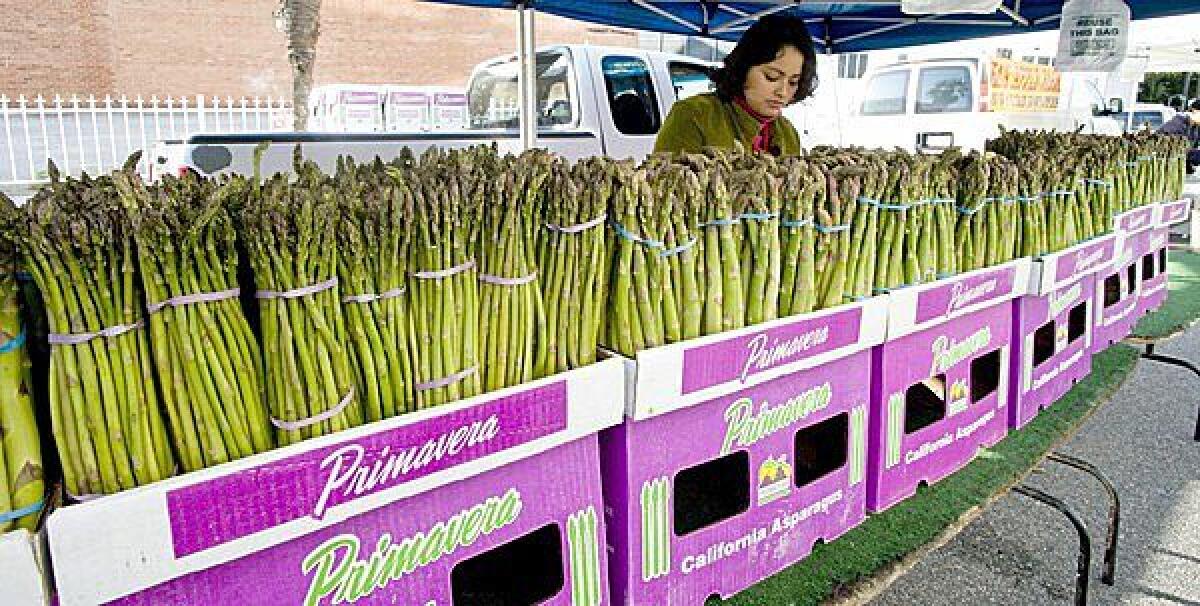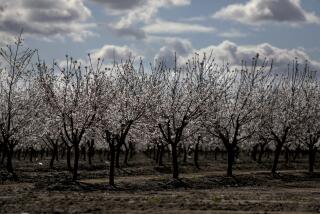Market watch: Hard times for California asparagus

The long ranks of asparagus bunches standing at attention at the Zuckerman stalls at local farmers markets look much the same as in previous years, and the green, herbaceous spears are just as tender and delicious. But according to Roscoe Zuckerman, who grows in Holt, just west of Stockton, it may be getting close to the last stand for the San Joaquin Delta asparagus crop, a California tradition emblematic of springtime for more than a century.
Farmers often cry that the sky is falling when they are really just experiencing a cyclical downturn in markets, but hard facts back up Zuckerman’s concern. California still grows about 11,500 acres of asparagus, estimates Cherie Watte Angulo, executive director of the California Asparagus Commission. But this is down from 20,200 in 2007, and 40,900 in 2000. Twenty years ago, California produced 62% of the asparagus consumed in the United States; now its share is close to 10%, Angulo says.
The problem for California farmers is that labor for harvest, sorting and packing accounts for three-quarters of their cost of raising asparagus, and Mexico and Peru, which have much lower labor expenses, are able to sell far more cheaply. These two countries thus have come to dominate the United States market for most of the year.
Although asparagus thrives in many districts around California, from the Imperial Valley in the desert to Salinas near the coast, the primary growing area, with more than 7,000 acres, is the San Joaquin Delta. The peat soils, rich in organic matter, produce an abundant, tender, flavorful crop. The season typically starts in late February and ends sometime between mid-May and early June; the peak for quality and quantity is right now.
Before the Second World War, the Zuckerman family grew white asparagus, which workers dug up before the shoots emerged from the earth, for the cannery trade. This was even more labor-intensive than picking green asparagus. And so, during the war, when many of their Japanese American workers were interned in camps and labor was scarce, the Zuckermans shifted to shipping green spears.
In the late 1940s, the family grew some 4,000 acres of asparagus in the Stockton area; this now has fallen to 351. Last month, a glut of Mexican spears depressed wholesale prices below the cost of harvest. Roscoe plowed under most of his early fields, saving only enough to supply his farmers markets, which include Studio City, Long Beach (Friday and Sunday), Encino, Hollywood and Santa Monica (Wednesday and Saturday Organic).
It’s not just California asparagus growers who are the losers as cultivation declines. Imported asparagus may look much the same but lacks the freshness, flavor and texture of domestically grown spears. Even if California-grown asparagus continues to be available at farmers markets, our joy in this vernal delicacy may be tempered by the fading away of our state’s commercial industry.
Purple sprouting broccoli
When Alex Weiser brought out a bag of Early Purple sprouting broccoli last week at the Santa Monica Wednesday market, half a dozen chefs and produce foragers, and a few lucky public customers, swooped in and vied for the meager supplies, which vanished from the table within a few minutes, despite costing $7.50 a pound. Could any mere broccoli merit such a price and commotion?
Perhaps. When I managed to snare a small sample and taste-tested it against common green broccoli, the purple was far more intensely flavored. I haven’t yet compared it directly with broccoli De Cicco, an excellent heirloom green sprouting variety, which Weiser Family Farms also grows, but if memory serves, the purple did seem even richer.
If purple sprouting broccoli is so tasty and there’s such demand, why don’t farmers grow more of it? Part of the reason, Weiser explains, is that Early Purple and a similar variety that he grows called Red Arrow require overwintering to produce a crop, which means that they take space in the field for much longer than commercial broccoli varieties. Weiser grows only a quarter-acre of purple sprouting broccoli at his farm in Tehachapi, but he intends to plant more for next season. This year’s crop will run through April.
Hardly anyone grows purple sprouting broccoli in the United States, but it has been around for centuries in Europe and is particularly popular in British home gardens, both for its coldhardiness and its flavor. Breeders recently developed a purple sprouting hybrid called Bordeaux that does not require overwintering, so this type eventually may become more available here.
More to Read
Eat your way across L.A.
Get our weekly Tasting Notes newsletter for reviews, news and more.
You may occasionally receive promotional content from the Los Angeles Times.






